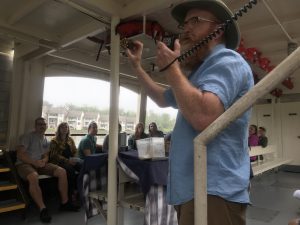UToledo Lake Erie Center to Outfit Floating Laboratory for Science Cruises
January 21st, 2021 by Christine BillauThe University of Toledo Lake Erie Center and its scientists will engage local teachers and hundreds of middle and high school students in hands-on learning on a new floating laboratory on the Maumee River.
The National Oceanic and Atmospheric Administration awarded UToledo a nearly $80,000 grant to fund the STEM educational project titled Maumee River FLOWS —floating laboratory on watershed science.

During a “Saturday Morning Science” cruise on the Sandpiper during the summer of 2019, Bridgeman explains to passengers how UToledo monitors the health of Lake Erie and its tributaries.
A central feature of the project is to transform the large Maumee River tour boat, the Sandpiper, into a laboratory for science and art classes by equipping it with sensors, sampling gear and water-testing equipment. Data available from NOAA buoys in nearby Lake Erie and U.S. Geological Survey river gauge stations will allow students to engage with live river and lake data throughout the year.
The funding, which runs through October 2022, also covers the cost of an estimated 30 science cruises aboard the Sandpiper during the 16 months of the project, which can accommodate about 600 students in total.
“Our goal is to foster in teachers and students an awareness and sense of connection with and responsibility for the waters of the Great Lakes,” said Dr. Thomas Bridgeman, professor of ecology and director of the UToledo Lake Erie Center.
“Hundreds of school-age children cross the Maumee River every day, yet have never had the opportunity to venture onto the river or touch the water. Many have never even seen Lake Erie, a mere five miles downstream. We want to get students out on the river, touching the water and becoming aware of its influence on their Great Lake.”
Focused on schools in and near the downtown area along the Maumee River, the project is joined by local partners including Toledo Public Schools, Toledo School for the Arts, Maritime Academy of Toledo, Lucas Soil and Water Conservation District, Partners for Clean Streams and the Sandpiper.
The Lake Erie Center plans to train 10 middle school and high school teachers to use the scientific equipment on board the Sandpiper and provide context to the adventure on the water when the class returns to school.
“The 2014 ‘Toledo Water Crisis’ made everyone in the region aware of the problem of harmful algal blooms, what we call HABs,” Bridgeman said. “Many residents, however, remain unaware of the central role of the Maumee River in gathering agricultural HAB-causing nutrients from the watershed and delivering them to Lake Erie and of the urban effects on the river stemming from storm-water drains, road salt runoff and sewage treatment plant outflows.”
Students will reflect and present their “meaningful watershed educational experience” through science presentations or artistic media.
Students and teachers also will work on stewardship action projects that focus on urban effects on waterways, such as labelling and protecting street storm drains, installing rain barrels and rain gardens, designing alternate parking lot salting schemes, or stream litter removal.
The project is designed to accommodate social distancing and safety procedures required by the COVID-19 pandemic.
“The passenger deck of the Sandpiper is an ideal platform for a socially distanced learning experience,” Bridgeman said. “Designed to carry 100 passengers, the Sandpiper can carry up to 50 passengers with social distancing and an ideal class size of up to 30 students.”
The Lake Erie Center is UToledo’s freshwater research and science education campus focused on finding solutions to water quality issues that face the Great Lakes, including harmful algal blooms, invasive species and pollutants.
Christine Billau is
UT's Media Relations Specialist. Contact her at 419.530.2077 or christine.billau@utoledo.edu.
Email this author | All posts by
Christine Billau

